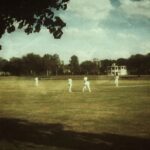Greatest Moments in NFL Playoff History: Moments 1-10
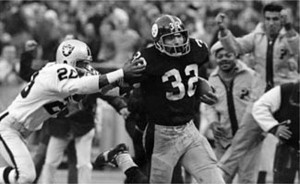
The miracle reception by Franco Harris led to the first of many playoff victories for the Pittsburgh Steelers.
We have spent the last week counting down the top 50 moments in NFL Playoff History (since the beginning of the Super Bowl era in 1966), but it is now time to look at the “Best of the Best.”
So, here is the top 10 of the 50 Most Memorable NFL Playoff Moments.
10. 1999 AFC Wild Card Game-Bills vs. Titans “The Music City Miracle”
The Buffalo Bills appeared on their way to a victory over the Tennessee Titans when Steve Christie made a 41-yard field goal to give Buffalo a 16-15 lead with 16 seconds to go.
All the Bills had to do was kickoff to the Titans and not allow a big return and they would advance to the next round.
On the kickoff, Christie hit a pooch kick that was caught by Titans fullback Lorenzo Neal at the Titans’ 25-yard line. Neal handed the ball off to tight end Frank Wycheck who turned toward the left sideline and threw it back to wide receiver Kevin Dyson.
Dyson caught it and then ran 75 yards for a shocking touchdown with three seconds left.
The play was reviewed to see if Wycheck’s pass was a backwards lateral or a forward pass. If it were forward, it would negate the touchdown and give the game to the Bills.
Replays seemed to show the pass was parallel, not going forward or backwards, thus making it a lateral in referee Phil Luckett’s mind who upheld the decision.
The Music City Miracle gave Tennessee a 22-16 win and propelled them to their first Super Bowl.
9. 1987 AFC Championship Game-Browns vs. Broncos “The Fumble”
Browns running back Earnest Byner appears on his way for game-tying touchdown after taking a handoff from Bernie Kosar at the Broncos 8-yard-line with 1:12 remaining in regulation.
But at the 3-yard-line, Byner is stripped of the ball by Broncos defensive back Jeremiah Castille, forcing a fumble that is recovered by Castille.
The Broncos go on to win the game 38-33 after taking an intentional safety, and advance to their second consecutive Super Bowl.
Despite gaining 187 all-purpose yards and scoring 2 touchdowns, Byner is seen as the goat of the Browns’ second straight heartbreaking loss in the AFC Championship Game to the Broncos.
8. 1974 AFC Divisional Playoff-Dolphins vs. Raiders “The Sea of Hands”
Raiders quarterback Ken Stabler throws an 8-yard touchdown pass to running back Clarence Davis with 24 seconds to play, for the game-winning touchdown in a 28-26 win over the Miami Dolphins.
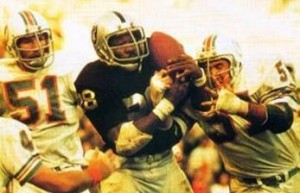
The touchdown catch by Clarence Davis ended the two-year championship run of the Miami Dolphins.
The touchdown occurs on a 2nd-and-4 from the 8-yard-line when Stabler has to scramble from the pocket after looking for Fred Biletnikoff who is covered in the back of the end zone. Stabler is pursued by Dolphins defensive end Vern Den Herder, who ends up getting his arms around the legs of Stabler to drag him down.
But before his knee hits the ground, Stabler lofts a desperation pass into the end zone that appears to be heading toward three Dolphins defenders, until Davis fights his way through the “sea of hands” to come away with the catch for the winning touchdown and ending the Dolphins’ two-year reign as NFL Champions and three-year reign as AFC Champions.
7. 2001 AFC Divisional Playoff-Raiders vs. Patriots “The Tuck Rule”
NFL fans were introduced to the “tuck rule” during this AFC Divisional Playoff that was played in a heavy snowstorm in the final game ever at Foxboro Stadium.
Late in the fourth quarter and trailing 13-10, the Patriots were at the Raiders’ 42-yard line when quarterback Tom Brady was drilled by Raiders cornerback Charles Woodson, causing a fumble which was recovered by linebacker Greg Biekert, seeming to end the Patriots’ hopes for victory.
However, the play was reviewed by the officials and after watching the replays, referee Walt Coleman ruled Brady’s arm was moving forward, making it an incomplete pass and letting the Patriots keep the ball.
The fumble was overturned because of the “tuck rule” where a ball is ruled incomplete after a quarterback starts a forward motion, even though Brady was bringing the ball back into his hands.
Nevertheless, the Patriots kept the ball and Brady drove New England inside the Raiders’ 30-yard line where Adam Vinatieri drilled a 45-yard field goal through the snow to tie the game at 13 with 27 seconds left in regulation and send the game into overtime.
Vinatieri then made a 23-yard field goal in overtime to give the Patriots a 16-13 win.
6. 1992 AFC Wild Card Game-Oilers vs. Bills “The Comeback”
Eight years after leading the Maryland Terripans back from a 31-0 deficit to the Miami Hurricanes in the greatest comeback in college football history, quarterback Frank Reich leads the Buffalo Bills to the greatest comeback in NFL history.
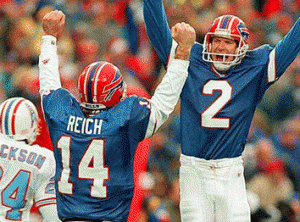
The game winning field goal by Steve Christie completed the Bills comeback from down 35-3.
Trailing 35-3 to the Houston Oilers with 13:19 to play in the third quarter, Reich and the Bills score 35 unanswered points to take their first lead of the game with 3:08 to go in the fourth quarter after a 17-yard touchdown pass from Reich to Andre Reed.
Warren Moon, who threw four touchdown passes in the first half, leads the Oilers on a 63-yard drive to set up Al Del Greco’s 26-yard field goal that tied the game at 38-38 and force the game into overtime.
The Oilers win the coin toss but Moon is intercepted on the third play by Nate Odomes, giving the Bills a first down at the Oilers 20-yard-line following a 15-yard facemask penalty on Oilers receiver Haywood Jefferies.
Three plays later, kicker Steve Christie kicks a 32-yard field goal to give the Bills a 41-38 victory and completing the greatest comeback in NFL history.
5. 1986 AFC Championship-Broncos vs. Browns “The Drive”
Following a 48-yard touchdown pass from Bernie Kosar to Brian Brennan that put them behind 20-13, the Broncos muff the ensuing kickoff and end up taking over the ball at their own 2-yard-line with 5:32 to play in the game.
That is when the legend of John Elway began as he lead the Broncos on a 15-play, 98-yard drive, which ends with a 5-yard touchdown pass from Elway to Mark Jackson, tying the game at 20-20 with 37 seconds left in regulation.
Then in overtime, Elway and the Broncos drive 60 yards on nine plays to set up Rich Karlis’ game-winning 33-yard field goal to send the Broncos to the Super Bowl with a 23-20 overtime victory.
4. 1981 AFC Divisional Playoff-Chargers vs. Dolphins “The Epic in Miami”
After the first quarter, this divisional playoff between the San Diego Chargers and the Miami Dolphins appear to be one of the worst playoff games of all time.
The Chargers jumped out to a 24-0 lead thanks two Miami turnovers that lead to touchdowns and a 59-yard punt return for a touchdown by Wes Chandler.
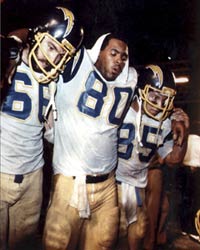
Kellen Winslow caught 13 passes and blocked a potential game winning field goal.
However, the Dolphins stormed back in the second quarter behind quarterback Don Strock, who replaced starter David Woodley, and lead the Dolphins to 17 unanswered points in the second quarter, including a “hook and lateral” on the final play of the first half when Strock hit Duriel Harris on the Chargers 25, who then lateral to running back Tony Nathan, who ran in untouched for the touchdown.
The Dolphins finally took the lead on the first play of the fourth quarter with a 12-yard touchdown run by Nathan that put Miami ahead 38-31.
Late in the fourth quarter, the Dolphins were driving for a potential game-icing score when fullback Andra Franklin fumbled, that was recovered by Chargers safety Pete Shaw at his own 18-yard line with 4:39 to go in regulation.
Led by quarterback Dan Fouts, the Chargers drove to the nine-yard-line where Fouts lofted a pass to the back of the end zone that was intended for tight end Kellen Winslow.
The ball sailed over Winslow’s head, but was caught by running back James Brooks that tied the game 38-38 with 58 seconds remaining.
Following a squib kick on the ensuing kickoff, the Dolphins drove 34 yards to the San Diego 26-yard-line where kicker Uwe von Schamann came on to attempt a 43-yard field goal with four seconds left.
But the block is kicked by tight end Kellen Winslow, sending the game into overtime where the Chargers have a chance to win the game with after winning the coin toss and marching down to the Dolphins’ ten-yard line.
But Rolf Benirschke hooks his 27-yard field goal to the left, keeping the Dolphins’ chances of winning alive.
Then, the Chargers blocked another von Schamann field goal, this time by defensive lineman LeRoy Jones giving the ball back to the Chargers at their 16-yard line.
Fouts then lead the Chargers 74 yards to the Miami ten-yard-line, setting up a second chance for Benirschke to win the game.
This time, Benirschke’s kick is true as his 29-yard field goal ends the game after 73 minutes and 52 seconds of play.
The defining image of this 41-38 classic comes after the game when Winslow, who finished the game with 13 receptions for 166 yards and one touchdown, is carried on the shoulders of two of his teammates because of his exhaustion and cramping from the heat and humidity of Miami.
3. 1967 NFL Championship Game-Cowboys vs. Packers “The Ice Bowl”
In a rematch of their 1966 NFL Championship Game, the Cowboys and the Packers play a classic game that is revered by NFL fans because of the conditions it was played in.
The game time temperature was -13 with a wind chill of -35, making this game the coldest game in NFL history.
The heating system underneath the grass surface at Lambeau Field failed, making the playing surface a sheet of ice and limiting traction for the players.
The Packers seem to adapt to the conditions better as they jump out to a 14-0 lead, but the Cowboys storm back and take a 17-14 lead on the first play of the fourth quarter when running back Dan Reeves throws a 50-yard touchdown pass to Lance Rentzel.
With 4:50 left and still behind by three points, the Packers get the ball at their own 32-yard-line, where they begin their last drive of the game.
Quarterback Bart Starr leads the Packers to the Cowboys’ one-yard-line where running back Donny Anderson was stopped twice from crossing the goal line, primarily because he could not keep his footing on the icy field.
After Anderson’s second run, Starr called the Packers’ last timeout with 16 seconds remaining and told coach Vince Lombardi that he could sneak it in for the touchdown.
Lombardi told Starr “Well, run it and let’s get the hell out of here”.
Starr snuck it in for the 1-yard touchdown thanks to a great block by guard Jerry Kramer on Cowboys defensive tackle Jethro Pugh, giving the Packers a 21-17 victory and their fifth NFL championship in seven years.
Two weeks later, the Packers defeated the Oakland Raiders 33-14 in Super Bowl II in Vince Lombardi’s last game as head coach of the Packers.
2. 1981 NFC Championship Game-Cowboys vs. 49ers “The Catch”
In a play that started the team of the 80’s, 49ers quarterback Joe Montana throws a 6-yard touchdown pass to Dwight Clark with 51 seconds to go, that gives the 49ers a 28-27 victory over the Dallas Cowboys, and sending San Francisco to its first Super Bowl.
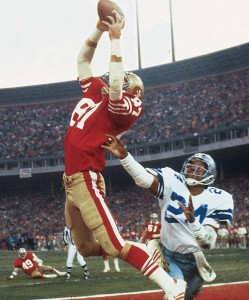
"The Catch" lifted the 49ers to their first Super Bowl.
The touchdown itself is legendary because of the difficulty of the throw by Montana and the catch by Clark.
Trailing 27-21 with 4:54 left in the game, the 49ers had the ball at their own 11-yard-line when Montana leads his team down 83 yards to set up a 3rd-and-3 from the six-yard-line.
That is where coach Bill Walsh called for “Sprint Right Option” a rollout pass to Freddie Solomon, which had produced a touchdown in the first quarter for the 49ers.
However, the play broke down immediately as Solomon coming off the line of scrimmage and Cowboys lineman Ed “Too Tall” Jones, D.D. Lewis, and Larry Bethea, all got pressure on Montana, forcing to scramble toward the right sideline.
Under the intense pressure, Montana throws a pass off his back foot that appears to be too high for anyone to catch and go out of bounds.
But at the back of the end zone was Clark, who jumped as high as he could to make a fingertip catch for the touchdown that put the 49ers ahead and produced the sixth lead change of the game.
While Clark’s catch is the most significant play of this game, many fans do not remember what happened when the Cowboys got the ball following “The Catch”.
On 1st-and-10 from the Dallas 25, quarterback Danny White found Drew Pearson across the field on a post pattern and nothing but green grass in front of him and the end zone when cornerback Eric Wright came in and tackled Pearson by the neck of his jersey with just one finger, bringing him down at the 49ers’ 44-yard line.
On the very next play, White is sacked by Lawrence Pillars, forcing a fumble that is recovered by defensive end Jim Stuckey, preserving the 28-27 victory.
Two weeks later, the 49ers defeated the Cincinnati Bengals 26-21 to win their first of four Super Bowls in the 1980s.
1. 1972 AFC Divisional Playoff-Raiders vs. Steelers “The Immaculate Reception”
It is the most memorable and controversial touchdown in NFL history. It is the “Immaculate Reception” a play that changed the fortunes of the Pittsburgh Steelers.
The Steelers were playing in their first playoff game in 25 years as they host the Oakland Raiders in a Divisional Playoff game.
The game was a defensive struggle as the Steelers lead 6-0 thanks to two field goals by Roy Gerela until Raiders quarterback Ken Stabler scored on a 30-yard touchdown run with 1:17 left in the game to give Oakland a 7-6 lead.
The Steelers had one last chance as they faced a 4th-and-10 at their own 40-yard-line with 22 seconds to go when head coach Chuck Noll called “66 Circle Option” a pass intended for rookie wide receiver Barry Pearson.
After taking the snap, quarterback Terry Bradshaw was forced to avoid the rush of Raiders lineman Tony Cline and Horace Jones, then fired a pass downfield to fullback John “Frenchy” Fuqua, who was at the Raiders’ 35-yard-line.
But as the ball was coming toward Fuqua, Raiders safety Jack Tatum came in and struck Fuqua, knocking him to the ground, and sending the ball backwards, where it appeared on its way to an incomplete pass.
That is when Steelers rookie running back Franco Harris, who run downfield after missing his block, scooped up the ball before it hit the ground at the Raiders’ 42, who runs down the left sideline for a 60-yard touchdown with five seconds left.
Steelers fans came out of the stands and mobbed the Steelers, even though the referees had not signaled touchdown.
The referees then went to the dugout to call Art McNally, the NFL supervisor of officials, to look at a video monitor to see if Tatum had touched the ball when he collided with Fuqua.
In 1972, it was illegal for two consecutive offensive players to touch the ball unless a defensive player touched the ball in between the two offensive players.
However, replays seemed inconclusive and a few minutes later, the head referee, Fred Swearingen came out of the dugout and signaled touchdown, giving the Steelers an improbable 13-7 victory, their first ever postseason victory.
While the Steelers lost in the AFC Championship Game the next week to the undefeated Miami Dolphins, the Steelers would go on to win four Super Bowls in the next six years to go down as one of the greatest dynasties in NFL history.
Check Out Earlier Entries in the Top 50:
Great Playoff Moments: 41-50
Great Playoff Moments: 31-40
Great Playoff Moments: 21-30
Great Playoff Moments: 11-20
Check back on Friday for moments 1-10.
